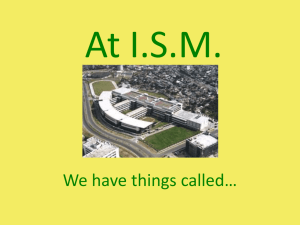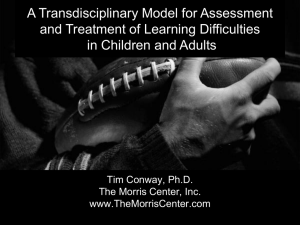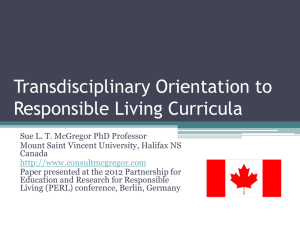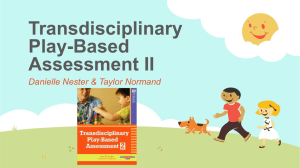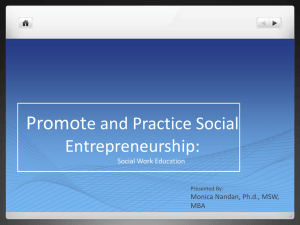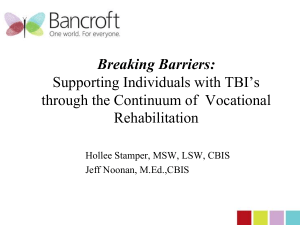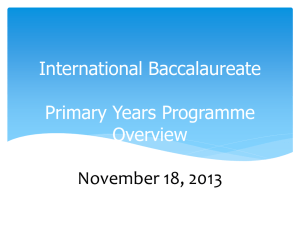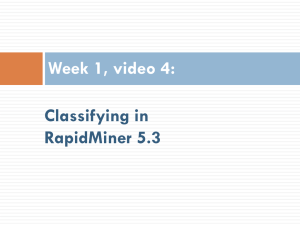Presentation4-13 - Transdisciplinary Learning
advertisement
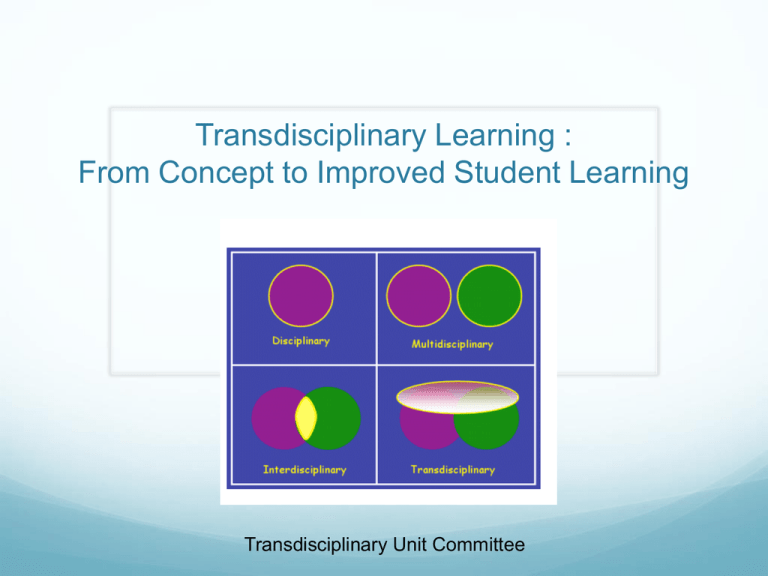
Transdisciplinary Learning : From Concept to Improved Student Learning Transdisciplinary Unit Committee Agenda Introduction – (Animoto - Butterfly CD) Powerpoint Presentation – Includes reading, introduction to UbD and overview of units Grade 1 Transdisciplinary Unit (example) Break A Day in the Life…(hand-out) Demo Wiki – http://transdisciplinary.greenwich.wikispaces.net Grade Level Break-out (explore wiki resources) Closure-( Prezi w/interviews with students in pilots). Essential Question: Why Transdisciplinary Learning? Briefly describe what transdisciplinary learning means and why we should teach this way. What are the critical differences between traditional teaching and transdisciplinary teaching? How does this approach relate to the Vision of the Graduate? Questions based on reading entitled “What is transdisciplinary learning?” – follow questions on next page. How is Transdisciplinary Learning Different from Multi- or Interdisciplinary? Multi- and interdisciplinary approaches use a theme to learn about multiple disciplines; The transdisciplinary approach focuses on the inquiry or process itself through the lenses of those disciplines. The inquiry topic or issue should be meaningful and relevant to the student, a problem that is complex and worthy of solving, can provide multiple perspectives for addressing and providing solutions. What is Inquiry? The inquiry topic or issue should be meaningful and relevant to the student, a problem that is complex and worthy of solving, can provide multiple perspectives for addressing and providing solutions. Inquiry: A student-centered, active learning approach focusing on questioning, critical thinking, and problem solving. It's associated with the idea "involve me and I understand." What is Transdisciplinary Learning? Transdisciplinary: Transdisciplinary learning is the exploration of a relevant issue or problem that integrates the perspectives of multiple disciplines in order to connect new knowledge and deeper understanding to real life experiences. Transdisciplinary units culminate in authentic assessments with a genuine audience. Transdisciplinary units weave throughout the school day and are taught through multiple disciplines. Transdisciplinary Learning Uses the Understanding by Design Framework The ‘Big Ideas’ of UbD What is UbD? 3 Stages of (“Backward”) Design 1. Identify desired results 2. Determine acceptable evidence 3. Plan learning experiences & instruction Understanding by Design Template The UbD template embodies the 3 stages of “Backward Design” Transdisciplinary Learning template mirrors this template. The “Big Ideas” of Each Stage: Standard(s): Stage 1: Identify desired results Unpack the content standards and ‘content’, focus on big ideas Understandings s t a g e 1 Essential Questions What are the big ideas? Assessment Evidence Stage 2: Determine acceptable evidence Analyze multiple sources of evidence, aligned with Stage 1 Performance Task(s): s t a g e 2 Other Evidence: What’s the evidence? LearningActivities Stage 3: Plan learning experiences and instruction Derive the implied learning from Stages 1&2 s t a g e 3 How will we get there? EXAMPLE OF UNIT PLAN BASED ON UbD FRAMEWORK Essential Questions and Transdisciplinary Learning Essential questions frame the unit by provoking genuine inquiry and deep thought. In developing units, much time was spent on developing a “burning” question that was worthy of inquiry or investigation. “burning” question What Are Essential Questions? Are arguable - and important to argue about. Are at the heart of the subject. recur - and should recur - in life and throughout the K-12 classrooms. raise more questions – provoking and sustaining engaged inquiry. often raise important conceptual or philosophical issues. can provide organizing purpose for meaningful & connected learning - are interdisciplinary. Examples of Essential Questions: What is friendship? Who are your true friends? What is the relationship between popularity and greatness in literature? Why did (do) people come to the United States? What is the American Dream (is it fact or fiction)? How has technology changed society? You’ve got to go below the surface... to uncover the really ‘big ideas.’ Transdisciplinary Units Grades K-2 Grade Unit Enduring Understanding Essential Question(s) Subject Area(s) Performance Task K Weather Matters Change in our environment affect us. How can observing patterns help us predict and understand? How can understanding changes in the weather help us to survive? Science, Math, Language Arts/Poetry, Social Studies , Media Weather report for season of student’s choice, expressing what the weather is like at that time and making a connection to their own life. 1 Survival All living things have needs. What do we all need to thrive in our community? Science, Social Studies, Math, Language Arts, Media Students create a habitat for an assigned living thing as members of a research team for the Museum of Natural History. 2 Botany Science, Language Arts, Media Transdisciplinary Units Grades 3-5 Grade Unit Enduring Understanding Essential Question Subject Area(s) Performance Task 3 Change is Part of our World Change has positive and negative affects. Why adapt? science, social studies, language arts, media and art. Webquest Everything changes . How do we determine the impact of change? Presentation – Biome Research and Zoo Exhibit How do we evaluate the impact of change? Is all change good? 4 Social Responsibility How are we interconnected? Healthy oceans are necessary for a healthy planet including all its populations. Science, language arts, media Letters in Advocacy of a Solution (ex: pollution in L.I. Sound, negative impact of humans on ecosystems) Public Service Announcement 5 Perspective The position of the Earth in the Solar System affects the conditions of life on our planet How does your perspective alter your view of the world? Science, language arts, media Choice of multimedia presentation demonstrating understanding of the earth’s position in the solar system and how that position sustains life on planet Earth. IMPORTANT TO NOTE FROM THE PLAN The Transdisciplinary Unit aligns with science, media, language arts – reading and writing – as well as the Arts. This is NOT an additional UNIT but replaces one of the three science units for the grade-level. Units are intentionally aligned with Reading/Writing nonfiction units and include digital texts. Resources, foundational lessons, assessments – and in some cases, Smartboard files ready to support teachers. Additional time for PD to delve into units will be provided next year. DISCUSSION How can this learning approach connect into my current classroom practice? Resources/ Support UbD/Transdisciplinary articles Wiki resources : http://transdisciplinary.greenwich.wikispaces.net Non-fiction text sets/digital bins Webquest: Resources for Transdisciplinary Learning http://www.greenwichschools.org/page.cfm?p=9652

